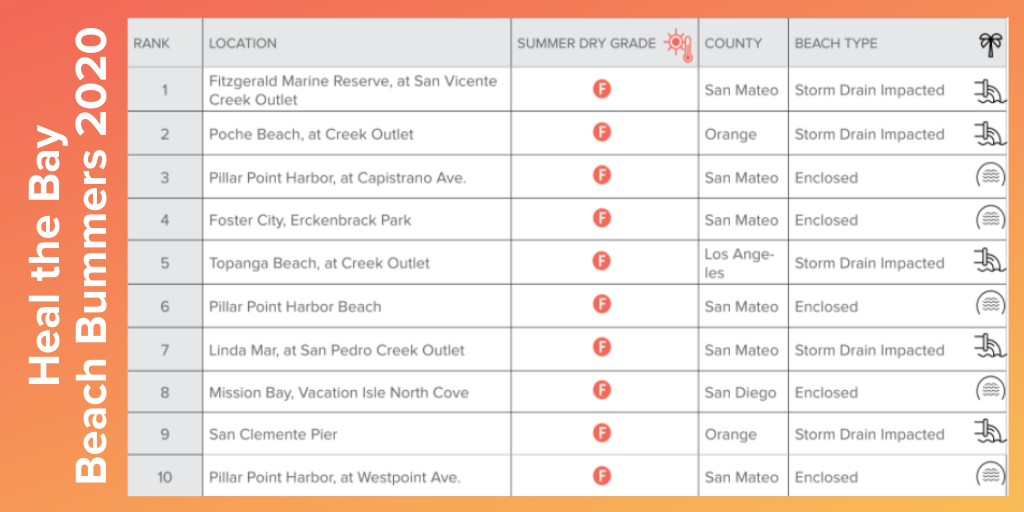The Top 10 Beach Bummers in California 2020

Every year, Heal the Bay staff scientists assign A-to-F letter grades to beaches all along the California coast. These grades are based on bacteria pollution and help inform public health. This year, 92% of 500 California beaches received an A or B grade for the busy summer season. However, several beaches are on our list of no-goes.
We’re announcing our 2019-2020 Beach Bummers List, a ranking of the ten most polluted beaches in the state based on levels of harmful bacteria. This year, six of the ten Beach Bummers are from San Mateo County and the remaining four are in Southern California.
The Beach Bummers of 2020
- No. 1 – Fitzgerald Marine Reserve at San Vicente Creek Outlet (San Mateo County) Fitzgerald Marine Reserve has never appeared on the Beach Bummer list before. The beach generally has good summer water quality, but is impacted by dry weather runoff from San Vicente Creek. This beach is one of six San Mateo County Beach Bummers this year, which is unprecedented for one county.
- No. 2 – Poche Beach at Creek Outlet (Orange County) Poche Beach is no stranger to the Beach Bummer list, appearing on the list in 2018, 2013, 2012, and 2011. The beach is impacted by the Prima Deshecha Cañada storm drain (referred to as Poche Creek), which carries pollution into the ocean even during dry weather from the Dana Point area.
- No. 3 – Pillar Point Harbor at Capistrano Avenue (San Mateo County) Pillar Point Harbor at Capistrano Avenue is one of three Pillar Point Harbor Beach Bummers this year. There are several storm drains that carry pollutants into the harbor in dry weather, and the seawalls around the harbor prevent pollutants from getting flushed away.
- No. 4 – Foster City, Erckenbrack Park (San Mateo County) Erckenbrack Park is a first time Beach Bummer; however, this area of the San Francisco Bay has had a known record of poor water quality. This beach lies within an engineered patchwork of enclosed channels that are impacted by dry weather runoff from the surrounding residential and commercial developments.
- No. 5 – Topanga Beach at Creek Outlet (Los Angeles County) A 2014 study found Topanga Lagoon as the likely source of bacteria pollution at Topanga Beach. The lagoon sees high amounts of bird and dog fecal matter. When breached, the fecal matter flows into the ocean resulting in high bacteria concentrations. Planning for a lagoon restoration is underway and could mitigate poor water quality.
- No. 6 – Pillar Point Harbor Beach (San Mateo County) Pillar Point Harbor Beach is the second of three Beach Bummers contained within the Pillar Point Harbor. Unfortunately, it appears that the entire harbor was more polluted than normal this past year.
- No. 7 – Linda Mar Beach at San Pedro Creek (San Mateo County) Linda Mar Beach is making its third consecutive appearance on the Beach Bummer list this year, and is one of six San Mateo County Bummers. This beach is impacted by runoff during dry weather, which flows untreated into the ocean through San Pedro Creek.
- No. 8 – Mission Bay, Vacation Isle North Cove (San Diego County) Vacation Isle North Cove is an enclosed beach in Mission Bay that is impacted by dry weather runoff from the surrounding commercial and residential developments. Pollutants are not easily flushed away from this enclosed beach, which is located within a deep cove.
- No. 9 – San Clemente Pier (Orange County) San Clemente Pier is making its second consecutive appearance on the Beach Bummer list and is one of two Orange County Beach Bummers this year. This beach is impacted by untreated dry weather runoff that flows into the ocean through a storm drain.
- No. 10 – Pillar Point Harbor at Westpoint Avenue (San Mateo County) Rounding out the Beach Bummer list is Pillar Point Harbor at Westpoint Avenue, which is the third Pillar Point Harbor Beach Bummer and one of six San Mateo County Beach Bummers this year. Untreated dry weather runoff appears to be causing significant water quality problems in this enclosed harbor.
For a detailed look at beach results by location, why some beaches are more vulnerable to higher levels of pollution, and more information about the Beach Bummers (pages 16-18), refer to our complete annual Beach Report Card 2019-20.
Polluted ocean waters are a significant health risk to beachgoers. We encourage all beachgoers to check the Beach Report Card when planning a trip to the ocean! Because a day at the beach shouldn’t make anyone sick.
Coming into contact with beach water that has a grade of C or lower greatly increases the risk of contracting illnesses such as stomach flu, ear infections, upper respiratory infections, and rashes.



